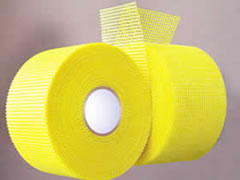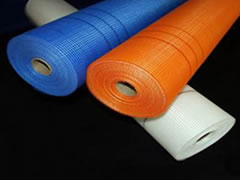Alkali Resistant Fiberglass Mesh Forms (Rolls, Strips or Pieces, Tapes). Coated with acrylic acid copolymer or latex. Water proof fabrics for concrete reinforcement. How and Why it is Suitable for Building Materials from Aspects of Base Material Treatment, Weave, Unit Weight, Mesh, Tensile Strength and Linear Density.
Alkali resistant fiberglass mesh fabrics are supplied in rolls, cut stripes or piece and fiberglass tape with measured width. The coated fiberglass woven textiles are widely used in the construction industry to reinforce the tensile, impact and flexural strengths of plasters, renderings (stuccos system) and concrete walls slab system building.
Fiberglass mesh screen is modern material for building of External Insulation Finishing Systems (EIFS) or in other words, External Thermo Insulating Composite Systems (ETICS).
 |
 |
| EIFS Fiberglass Mesh Stripes | Fiberglass Mesh Rolls |
Fiberglass fabrics are manufactured from glass yarns. The quality of the yarn bears a direct impact οn the quality of the final product.
The environment of the cement mixes (plasters, renderings or stuccos, screeds etc.) is very caustic due to the high alkalinity of cement and lime.
To withstand this caustic/alkaline environment the yarns have to be protected with a substance resistant to strong alkalis. Most usually an acrylic acid copolymer or an SBR latex play this role.
The fabric is immersed in a liquid bath and its yarns are completely covered with the protective substance. Such treated fiberglass fabric becomes an alkali resistant fabric.
Alkali resistant fiberglass mesh fabrics vary a lot with the weight. Usually this weight ranges from 50-450 gr/m2.
Obviously the heavier products are stronger, with a higher impact and tensile strength and they are used in places where high stresses are present.
Alkali resistant fiberglass meshes vary also a lot with their mesh dimensions.
Hereunder we will cite the most common mesh dimensions and their relevant applications:
Mesh dimension 2x2mm: Used for the reinforcement of one component or two components cementitious, brushable waterproofing slurries.
The combination of two-component flexible waterproofing products with fiberglass mesh fabrics gives very interesting and potent solutions for:
-the waterproofing of balconies and terraces destined to receive as final layer ceramic tiles. The tiles can be placed directly on the waterproofing layer with the aid of thin bed adhesives.
-the waterproofing of exposed water tanks/reservoirs or water towers. These constructions are stressed considerably due to the continuous temperature variations. The waterproofing layer should have a high tensile strength and the fiberglass mesh fabrics come to play this role.
-the waterproofing of surfaces with a generalized cracking profile. Since it is impossible to treat each crack individually, the only viable solution – except for using special liners – is to combine flexible cementitious waterproofing products with fiberglass mesh fabrics.
Mesh dimension 3x3mm: Used mainly for the preparation of cement boards.
Mesh dimension 4x4mm: Depending on the weight this item has more than one uses.
At a weight of 160gr/m2 this is the commonest fiberglass mesh fabric to be used as an integral part in EIFS or ETICS.
At a weight of 80-100gr/m2 it is used for the reinforcement of ready to use plasters in the interior.
Mesh dimensions 5x5mm or 6x6mm: These alkali resistant fiberglass mesh fabrics are used to reinforce prepackaged plasters in the interior.
Usual weights: 80-110gr/m2.
Mesh dimensions 10x10mm to 12x12mm: These types – usually colored – are used to reinforce in situ produced stuccos/renderings and screeds.
Usual weights: 110-200gr/m2. They are used for interior and exterior applications.
Finally there are the “panzer” type fiberglass mesh fabrics which are extremely strong and come at weights usually more than 300gr/m2.
They are used to reinforce the impact strength of renderings in public buildings. Typically they have more than one yarns in the warp direction.
Tensile strength is one of the most important criteria we use in order to choose an alkali resistant fiberglass mesh fabric. It’s expressed in N/5cm units calculated for both directions.
Tensile strength after immersion in a strongly alkaline solution – usually a 50% concentration solution of NaOH – is very critical. This test is a simulation of the influence of lime/cement on the mesh. It gives a safe prediction for the future behaviour of the fiberglass mesh fabric in the real world strongly alkaline environment of stuccos/renderings or other cement mixes.
The remaining tensile strength should be at least the 50% of the initial.
Different norms prescribe the minimum remaining tensile strength a mesh should have depending on its end use.
Weaving Types: For most alkali resistant fiberglass mesh fabrics a type of a leno weave is used. Leno weave is used to improve the stability of fabrics with low fiber count.
According this weave type, two adjacent warp yarns are twisted around the weft yarns and lock them securely to form a stable grid.
Material Linear Density: It is calculated for both the weft and warp directions and is expressed in TEX units.
When we say that a yarn is TEX 200, we mean that 1000 linear meters of this yarn weigh 200gr.
If we say that a yarn is TEX 200 x 2, this should imply a two ply yarn.
Higher Material Linear Density means a stronger yarn, with a higher tensile strength.
Alkali resistant fiberglass screen with high linear density makes ideal building fabrics used in concrete constructions. Learn about How to Using Fiberglass Mesh Fabric Properly in Wall Plastering.
- Fire-Retardant Fiberglass Mesh
- Fiberglass Propylene Polymer Self Adhesive Mesh
- Fiberglass Mesh with Covering PVC
- Fiberglass Mesh Strips Cut to Size
- C Glass Fiberglass Mesh
- Plisse Screen Mesh for Windows and Doors
- Fiberglass Mesh Building Materials
- Fiberglass Mesh
- Fiberglass Insect Screen
- Charcoal Fiberglass Window Screen
- Fiberglass Sunshade Screen.
- Fiberglass Geogrid Fabrics
- Fiberglass Portiere
- Glass Fibre Mesh Fabrics of Ducting.
- Coated Alkaline-resistant Fiberglass Mesh
- fiberglass self-adhesive joint tape
- Fiberglass Mosaic Tile Mesh
- Fiberglass Mesh Tape
- Fiberglass Mesh for Concrete Reinforcing
- fiberglass screen
- Tips on Using Fiberglass Mesh for Wall Plastering
- Fiberglass Screening for Enclosures
- Fiberglass Replacement Screen
- Solar Fiberglass Screen Mesh
- Wire Mesh Market
- Wetter Stainless Steel Wire Mesh
- Anping Barbed Wire Factory
- Hope Wire Mesh Factory
- Expanded Metal Factory
- Anping Chain Link Fence Factory